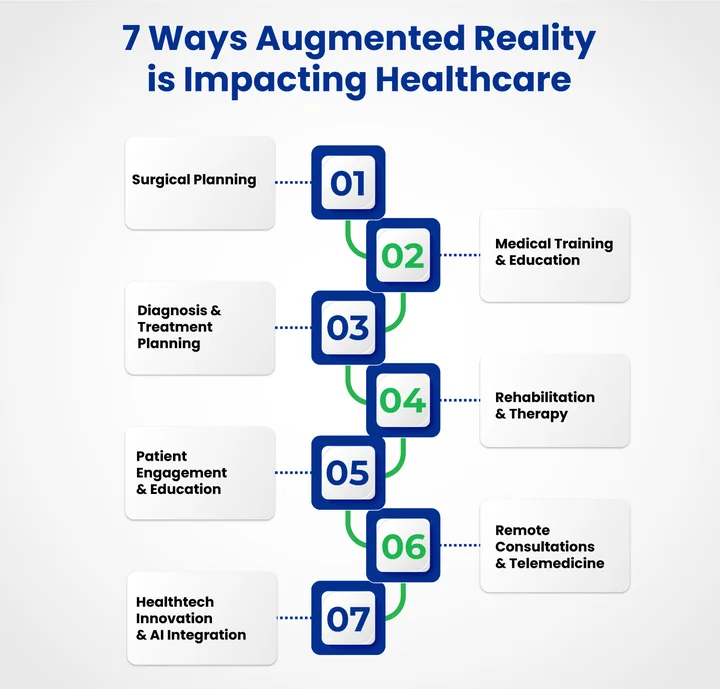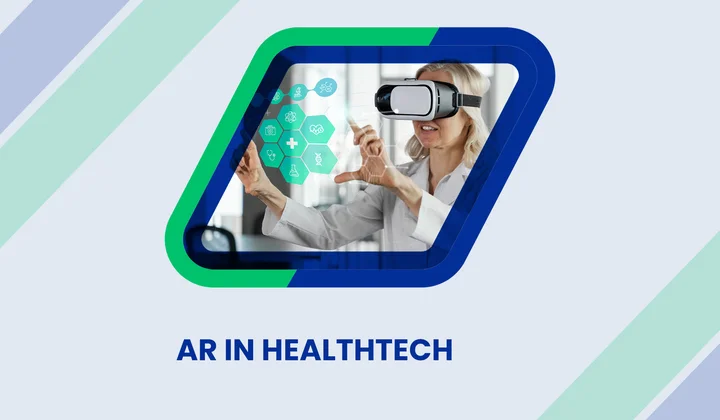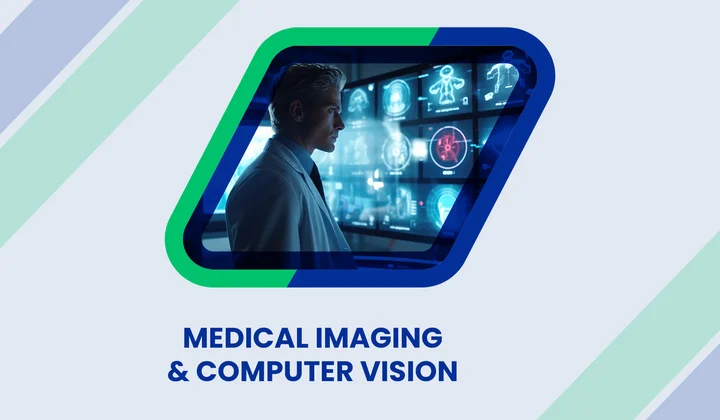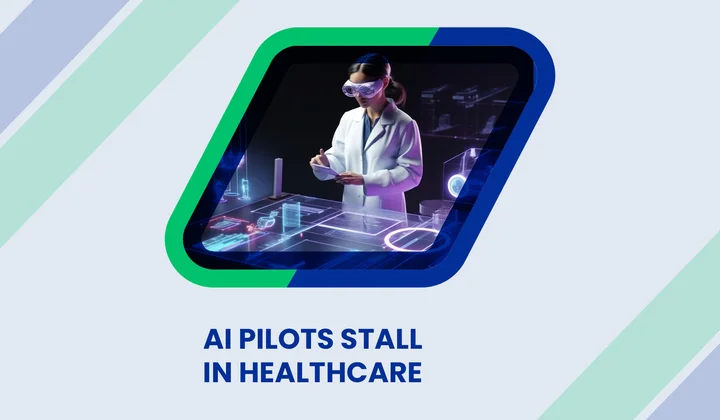Imagine a surgeon preparing for a complex operation and being able to see a patient’s organs in 3D before making a single incision. Similarly, medical students can practice intricate procedures repeatedly without putting anyone at risk.
These scenarios might sound futuristic, yet AR medical applications make them real today. In healthcare, augmented reality brings virtual information to life, improving planning, training, and patient care.
Interestingly, the global AR healthcare market was valued at around USD 2.36 billion in 2024 and is expected to grow to USD 11.31 billion by 2033, with a CAGR of nearly 19%.
This rapid growth highlights how hospitals, clinics, and educational institutions increasingly adopt AR to enhance precision, efficiency, and patient outcomes. As a result, the technology is becoming an essential part of modern medicine.
But what exactly makes AR so impactful in healthcare?
Let’s explore 7 real-world use cases that highlight its growing role in the medical field.
Why Does Augmented Reality Matter in Healthcare & Healthtech?
Physical constraints no longer limit immersive medical education and hands-on patient care. Augmented reality diagnostics and visualization tools combine the digital and physical worlds, enabling doctors, students, and patients to see, learn, and interact with medical information in new ways.
Augmented reality in healthcare technology is improving care by making it safer, smarter, and more connected.
Table of Contents
This explains why it is so important:

1. Precision in Medical Procedures
In medical procedures, Surgeons can now view 3D visuals of organs, bones, or tissues before making a single cut. This AR surgical planning helps them carefully plan every step, reducing mistakes and improving patients’ recovery.
2. Smarter Training for Future Doctors
Medical students can safely practice procedures in realistic simulations. They can interact with 3D models, perform virtual surgeries, and get instant feedback, which builds confidence and improves skills without putting anyone at risk.
3. Better Diagnosis and Treatment Planning
AR helps doctors see what’s going on inside the body by projecting scans and patient data directly into view. It makes it easier to detect problems early and plan treatments that fit each patient’s needs.
4. A New Level of Patient Understanding
Explaining medical conditions isn’t always easy. AR patient care tools help doctors show rather than tell. Patients can view 3D images of their heart, joints, or organs, which help them understand their condition and feel more at ease before treatment.
5. More Meaningful Remote Care
In telemedicine, AR creates a shared visual space that enables doctors and patients to connect more effectively. A specialist can guide a patient through a basic check-up or explain test results as if they were in the same room.
6. Innovation Across Healthtech
AR isn’t limited to hospitals. Startups and healthtech development solutions are using it to develop rehabilitation tools, medical wearables, and virtual assistants supporting patients and professionals. This new wave of innovation is redefining how care is delivered.
In simple terms, AR brings clarity where there is uncertainty and confidence where there is complexity. It’s helping healthcare feel more human, precise, and connected, one experience at a time.
Medical procedures can fail without clear visualization. Use AR technology to guide every step, improve outcomes, and build patient trust.
Now that we’ve set the stage, it’s time to see how AR can improve healthcare.

Use Case #01: AR for Surgical Planning and Assistance
Surgical procedures are becoming increasingly complex, and even the slightest miscalculation can affect patient outcomes. Augmented reality provides surgeons with detailed 3D visualizations of a patient’s anatomy, allowing them to plan every step precisely.
Reports suggest that AR-assisted surgical planning can reduce procedural errors by nearly 30%, directly contributing to safer surgeries and faster recoveries.
The primary benefits of AR in surgical planning include:
- Improved precision in complex procedures
- Real-time visualization of critical structures such as blood vessels and tumor margins
- Reduced operating times and postoperative complications
- Enhanced collaboration between surgeons, even remotely
- Better training and guidance for junior surgeons
Furthermore, AR allows surgeons to overlay critical information directly onto the patient during operations, improving decision-making in high-pressure scenarios.
For instance, neurosurgeons have successfully used AR to navigate intricate brain structures, while orthopedic surgeons employ it to map bone structures before joint replacements.
While AR improves surgical precision, it’s equally beneficial in how future doctors learn.
Use Case #02: AR in Medical Training and Education
Mastering complex medical procedures can be daunting for students. Medical AR training provides immersive simulations that let trainees practice safely and repeatedly, improving skill and confidence.
For example, students preparing for cardiac surgery can use AR headsets to interact with a 3D heart, perform virtual incisions, and observe blood flow without touching a patient.
The essential advantages of AR in medical training include:
- Safe practice for complex procedures
- Interactive, immersive learning experiences
- Immediate feedback from instructors
- Improved retention and skill acquisition
Additionally, AR enables remote guidance, allowing instructors to support multiple students in real time. This technology ensures that trainees are better prepared for clinical environments, bridging gaps in traditional medical education.
Beyond training, AR also enhances how doctors diagnose and plan personalized treatments.
Use Case #03: AR for Patient Diagnosis and Treatment
Diagnosing complex conditions can be time-consuming and prone to error. Augmented reality enhances diagnostic accuracy by directly overlaying patient data, imaging scans, and 3D models onto the patient or a virtual interface.
This allows clinicians to identify issues faster and plan treatments more effectively.
For instance, imagine a patient experiencing unexplained abdominal pain. Using AR, a doctor can overlay 3D scans of the patient’s organs to examine the digestive tract, identify inflammation or blockages, and plan the most effective treatment.
The doctor can even simulate different treatment paths virtually to predict outcomes, improving precision while minimizing risks.
Among the main advantages of AR in diagnosis and treatment are:
- Improved visualization of internal structures
- Faster and more accurate diagnoses
- Further planning for personalized treatments
- Reduced risk of errors and complications
Furthermore, AR in surgery also guides minimally invasive procedures, allowing precise treatments with real-time feedback.
Once diagnosis and treatment are refined, AR continues to add value in patient recovery and rehabilitation.
Use Case #04: AR in Rehabilitation and Therapy
Recovering from an injury or surgery isn’t easy. Physical therapy can feel repetitive and frustrating. Augmented reality changes that by turning recovery into an interactive, motivating experience.
With AR, patients can follow visual guides and movement cues overlaid in their real environment. They receive instant feedback to correct their posture or motion in real time.
Example scenario:
A patient recovering from a shoulder injury uses an AR headset to see a virtual ball appear midair. They are guided to reach out and “touch” it, earning points for each successful move. It feels more like a game than a chore, and every action helps track progress.
AR’s main advantages for rehabilitation include:
- Real-time feedback to improve accuracy
- Gamified exercises that boost motivation
- Personalized therapy plans with live progress tracking
- Remote monitoring for therapists
- Faster, more consistent recoveries
Additionally, Hospitals already use AR for stroke recovery, post-surgery rehab, and motor training, making therapy more engaging, accurate, and rewarding for patients.
Beyond rehabilitation, AR also helps patients better understand their conditions and treatments.
Use Cases #05 AR for Patient Engagement and Education
For many patients, understanding a diagnosis or treatment plan can be confusing. Augmented reality helps turn medical explanations into 3D visual experiences that patients can see and interact with.
Instead of relying on charts or verbal descriptions, doctors can use AR to show what is happening inside the body, such as how a joint moves or where a blockage is forming.
Example scenario:
A cardiologist explaining bypass surgery can project a 3D model of the patient’s heart, highlighting the location of the blockage and how blood flow will be restored. This visual understanding helps patients feel more informed and less anxious about the procedure.
The following are some of the advantages of AR for patient engagement:
- Easier understanding of complex medical conditions
- Improved communication between doctors and patients
- Greater confidence and trust in treatment plans
- Reduced anxiety before procedures
AR is also used in mobile health apps, allowing patients to visualize progress and learn about their conditions more interactively.
As patient engagement grows, AR extends its benefits to virtual consultations and remote care.
Use Case #06: AR in Remote Consultations and Telemedicine
Remote healthcare has made it easier for patients to connect with doctors without visiting a clinic. Augmented reality takes this further by creating more interactive and accurate virtual consultations.
Through AR, doctors can visualize patients’ symptoms in real time and even guide them through basic examinations. Patients can share live visuals of affected areas using AR-enabled cameras, helping doctors make faster and more informed decisions.
Example scenario:
Imagine a patient living in a remote area who has injured their wrist. The doctor uses AR to overlay a virtual skeletal model on the patient’s wrist through their phone camera during telemedicine.
This allows the doctor to explain the possible issue, demonstrate movement limitations, and guide the patient through safe exercises or temporary care until an in-person visit is possible.
AR has several advantages for remote consultations, including:
- Better visualization of patient symptoms during video calls
- Real-time guidance for basic assessments or treatments
- Reduced the need for unnecessary clinic visits
- Improved access to care for patients in remote locations
- Improved doctor-patient communication through shared visual context
Combining AR and telemedicine allows healthcare providers to provide a more connected and informed virtual care experience. It makes remote consultations more convenient, accurate, personal, and effective.
With these advancements already reshaping care delivery, the next frontier for AR lies in its future innovations.
Use Case #07: Future Trends of AR in Healthcare
Over the past few years, Augmented reality has steadily evolved into a core technology for diagnosis, treatment, and patient engagement.
The next wave of innovation will combine AR, AI, and wearable tech, changing how clinicians access data, perform procedures, and interact with patients.
The numbers already hint at what’s ahead. 91% of surgeons believe VR-based simulation improves medical training, and students who train with XR complete procedures 20% faster and perform 38% more steps correctly than those learning the traditional way. (ITIF Report)
Example scenario:
Imagine this: an emergency medical team wearing AR glasses can instantly view a patient’s vitals and history while performing first aid. As a result, they can make faster, more accurate decisions when every second counts.
To keep an eye on:
- Integration of AR with AI for real-time decision support
- Growth of AR wearables for everyday clinical use
- Expansion of AR-guided surgeries and remote assistance
While AR paves new paths in healthcare, its impact extends beyond medicine. Industries like finance are also adopting immersive tools.
For instance, AR in banking is driving more personalized and immersive digital experiences, a sign of how deeply this technology is reshaping industries.
Within healthcare, however, the journey is just beginning. With each breakthrough, AR brings us closer to a system that’s not only smarter and more connected but also more personal and human at its core.
Final Takeaway: How is AR Shaping the Future of Healthcare?
As we’ve seen, augmented reality steadily shifts healthcare, from helping surgeons plan more precisely to making patient education more interactive and accessible. Each use case highlights one truth: when technology enhances understanding, outcomes improve.
But here’s the real question: how can healthcare organizations turn these possibilities into practical solutions that work in real-world settings?
The answer lies in thoughtful healthtech software development services that bridge medical expertise with innovation. When AR tools are built on secure, well-designed platforms, they deliver measurable impact, improving accuracy, training, and patient engagement.
In the end, augmented reality is redefining how care feels. We’re heading toward a more progressive, human, and connected healthcare ecosystem where innovation and empathy coexist, combining deliberate design with technology and purpose.
Frequently Asked Questions
2. What are the Benefits of Using Augmented Reality in Surgical Procedures?
The biggest advantage of AR in surgery is precision. During surgery, surgeons can access a live 3D view of the patient’s anatomy (veins, muscles, or tumors) right over the body. This reduces the need for large incisions and lowers risk.
Other benefits include:
- Better pre-surgery planning with 3D visualization.
- Real-time guidance during complex surgeries.
- Shorter recovery times and improved patient safety.
With these advantages, AR is making critical surgeries safer and data-driven.
3. How is AR used in Medical Training and Education?
AR makes medical education more hands-on and engaging. Instead of only reading from textbooks, students can explore 3D models of the human body, zoom in on organs, or simulate real surgeries.
- It allows repeated practice without risking a patient’s life.
- Instructors can monitor and guide students in real time.
- Complicated concepts become easier to visualize and understand.
4. How is AR being Used for Patient Diagnosis and Treatment Planning?
Augmented reality diagnostics overlays scans and patient data in real time, helping clinicians identify issues faster and design personalized treatment plans. It’s beneficial for minimally invasive procedures and complex conditions.
5. What Does the Future of AR Look Like in Healthcare and Healthtech?
The future of AR healthcare technology includes AI integration, wearable AR devices, and expanded applications in telemedicine, rehabilitation, and patient monitoring. Immersive technologies in healthcare education and care are set to make medical practices safer, smarter, and more connected.
Healthcare organizations can improve patient care with AR-powered solutions. Partner with Clustox to build or integrate AR software designed for your needs.








Share your thoughts about this blog!